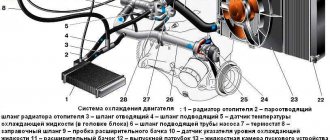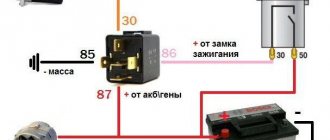If the VAZ-2107 is not charging, then the entire on-board network is powered from the battery. In this case, the generator will not work at all. But the disadvantage of a rechargeable battery is that it does not last long. And if a breakdown of the generator or its charging circuit suddenly occurs, the malfunction must be repaired as quickly as possible. Otherwise, you risk continuing to drive on a tow truck or tow truck. In order to understand the reason for the lack of charging, you need to know at least the theory of how the generator set on a car works.
What is a generator
In order to start the engine and ensure its proper operation, the entire electrical system must be provided with constant voltage. If we talk specifically about the reasons why there is no charging on the VAZ-2107, then you need to take into account that this car requires a voltage of 12 V. The car is started by a starter - this is a high-power electric motor that spins the crankshaft. The generator does not work when the engine is idle.
As soon as the crankshaft begins to rotate, voltage from the battery is applied to the excitation winding of the generator. The generator can only operate if there is a rotational movement of the magnetic field. And if there is no charging on the VAZ-2107, then there is either no voltage on the rotor winding or no rotation. The magnetic field is created by the field winding, which is located on the rotor. There is a pulley on it, which is connected to the crankshaft by a ridge belt (on injection cars) and a V-belt (on carburetor cars) to the crankshaft.
Generator VAZ 2107 purpose and main functions
The performance of the battery on a VAZ-2107, as on many other cars, depends on three main parts: a generator, a voltage regulator, and connection systems for these two devices.
If, when a breakdown is detected, you still cannot fix the car, then the best solution would be to call a tow truck https://volok-evakuator.ru/lotoshino.html, which will deliver the car to a service station.
A machine generator set, a generator, is an element that performs the task of providing electricity to various components of the car, as well as providing a constant charge to the battery. The main components of the generator set include:
- housing with windings;
- anchor;
- current rectifier;
- stabilizer.
The generator set operates through a drive - a belt passing from the crankshaft pulley.
Voltage regulator
And most importantly, the VAZ-2107 charging lamp is connected to the excitation winding through a voltage regulator. The latter allows you to maintain the voltage at the same level - within 13.6-14.2 V. The design of the regulator can be absolutely any, the following designs are distinguished:
- Mechanical - work on electromagnetic relays.
- Electromechanical - work on electromagnetic relays and transistor switches. A kind of combined scheme.
- Electronic regulators - consist of a single crystal on which a switching circuit is made. Essentially, this is one large power switch that allows switching to maintain the required voltage level.
Indicator light
As can be seen from the diagram, the charging system involves a large number of components and each of them can cause poor charging or its absence. To monitor the battery charging process, the car's dashboard is equipped with a control light.
If the system is in good working order, the control signal turns on after the factory. But when the engine enters operating mode, the VAZ 2107 battery charging light does not light up. This means that the battery's energy supply is replenished from the generator. At the same time, the needle on the voltmeter moves to the green sector.
Signs of a battery not charging:
- The VAZ 2107 battery charge arrow twitches.
- The control signal does not go out. In some cases, the VAZ 2107 battery light blinks.
- The voltmeter needle does not go to the green zone after starting the engine.
- When the engine is running, the voltage on the battery should remain around 13.9.
- The permissible deviation in any direction does not exceed 0.3 V. Undercharging of the VAZ 2107 battery within these limits is not yet dangerous.
Breakdowns leading to loss of charge
But now let's figure out why the generator may lose charging. The VAZ-2107 has a simple design; there is nothing complicated in the power supply system.
Major breakdowns:
- Voltage regulator failure.
- Broken generator drive belt.
- Poor contact or break in the wires supplying the field winding.
In order to restore the functionality of the generator set, you need to understand what the causes of the breakdown may be. If there is no charging on the VAZ-2107, you need to carefully carry out diagnostics.
How does the battery charge in a VAZ 2107?
To understand how the process of charging the “seven” battery occurs, you need to know the principle of operation of the generator and understand the connection diagram of these devices.
Design, drive and characteristics of the VAZ 2107 generator
A car generator set serves to provide electricity to the vehicle’s on-board network, as well as to recharge the battery when the power unit is running. Structurally, it consists of the following main elements:
- housings with windings (stator);
- armatures (rotor);
- current conversion module (rectifier);
- stabilizer (voltage regulator).
The generator serves to provide electricity to the on-board network of the machine.
The installation is driven by a belt from the crankshaft pulley.
Throughout its history, the “Seven” was equipped with two types of generating sets: 372.3701 and 9412.3701. They have the same design and operating principle, except that in unit 9412.3701 the fan blades are located inside the housing, and the rectifier module is located outside.
Table: main technical characteristics of VAZ 2107 generator sets
| 372.3701 | 9412.3701 | |
| Rated voltage, V | 14 | 14 |
| Current at rated voltage and armature speed 5000 rpm, A | 55 | 80 |
| Maximum power, W | 770 | 1120 |
| Weight, kg | 4,5 | 4,9 |
The performance of these devices differs greatly in terms of the amount of current produced and power output. Generator 9412.3701 is more productive. It is used in injection “sevens”, where the on-board network is supplemented by an electronic engine control system.
How to understand that there is no charging
The first sign that charging has failed is that the lamp on the instrument panel lights up. The voltmeter needle may not respond (if, of course, the car has one). But the most reliable way to determine a breakdown is to check the voltage directly at the generator terminals.
When the engine is running, the voltage should be 13.6-14.2 V. If the battery is not charging, the voltage will be 12 V or lower. In order to avoid damage to the voltage regulator, do not remove the terminals from the battery while the engine is running.
It should be noted that too high or low voltage is harmful to the battery. It is either completely discharged (this leads to the fact that it is impossible to start the engine, since the starter does not rotate), or it is overcharged (at the same time, the electrolyte boils away from the cans). Of course, all these negative phenomena will lead to the battery failing.
Checking fuses of VAZ 2106 - 2107 with a multimeter
You also need to know how to check a fuse in a car with a multimeter because in some cases replacing it does not eliminate the malfunction; the circuit needs a more thorough check. Usually its failure is visible to the naked eye, but in some cases the break can be detected only after an instrumental check. To do this, use a car tester or even a simple voltmeter to measure direct current.
Read more: Which program to choose for
- We attach the probes to the fuse.
- Next, using simple manipulations, we melt the wiring inside the fuse. Therefore, we made a non-working fuse out of a working fuse. What won’t you do for a good article!? :-). Again we apply the probes to the fuse and look at the behavior of the multimeter.
- The resistance is infinitely large, we do not hear any sound signal like “peep”. The fuse is broken. It can be thrown into the trash bin.
On an ordinary weekday, I went out to the car and encountered one problem: the battery charging lamp on the VAZ 2107 does not light up. It stops lighting when the ignition is turned on, charging has disappeared, and the arrow only shows the level. Can anyone tell me what this is and how to fix it?
Hello! While the engine is running, the dead battery is supplied with constant voltage from the on-board network via a generator. The voltage is 13-14.2 V. As you know, the crankshaft rotates at different frequencies during engine operation.
To maintain a constant voltage, a special voltage regulator is included in the excitation circuit. It is the excitation circuit that does not allow the generator to supply the battery with the required voltage.
What is needed for repair?
In the event that the VAZ-2107 has lost its charge, you need to start repairs as quickly as possible. It is impossible to carry all the tools and equipment with you, but it is still worth having a minimum set in the glove compartment or trunk.
More specifically, you need to have the following set of tools:
- Voltage measuring device (multimeter).
- Lamp 12 volts and power no more than 3 W.
- Screwdrivers - flat and Phillips.
- Stationery knife for cleaning wires.
- Pliers.
- Sandpaper.
Having this entire set of tools, you can begin to carry out repairs. Fortunately, on a VAZ-2107 it’s quite easy to do this with your own hands.
Troubleshooting
The first thing to do is check the tension of the alternator drive belt. Let's look at the main reasons why charging on a VAZ-2107 may fail. The reasons can actually be anything - even a simple broken belt. Over time, it wears out and becomes unusable. On the "sevens" the belt also drives the coolant pump. And if the belt suddenly breaks, this can be seen by the fact that the temperature of the antifreeze in the engine block will instantly increase.
If the control light in the dashboard does not light up, and the voltage in the on-board network is at a normal level, but there is still no charging, you can look for the cause of this phenomenon in the terminals and contacts that connect the wires. Remove the terminals from the battery to clean them. Very often they are covered with a layer of oxides that interfere with the conduction of current. The result is a large voltage drop. Quite often, the fault lies not even in the charging wires themselves, but in the bus that connects the body, the engine block and the negative terminal of the battery.
Fuse relay is faulty
Another possible problem is a faulty relay. Some car modifications are equipped with a relay that monitors the battery charge light on the instrument panel. As soon as the relay fails, the indicator does not work either.
Fuse relay VAZ 2107
To test the relay, you should arm yourself with a multimeter. They measure the current at the positive output of the relay. If the voltage is less than 6V, then there is clearly a problem with the generating device. If the value is even higher, then the relay is faulty. It needs replacing.
Thus, finding out the reason why the battery light does not light is extremely important for adjusting the indicator and protecting the car from more serious malfunctions.
More complex breakdowns
If, when the engine is running, the voltage in the on-board network is in the normal range, but when the load increases, it immediately drops, then we can say that the alternator belt is very loosely tensioned. Quite often, at low speeds, the belt even begins to whistle. It should be noted that with normal belt tension, the sag should be no more than 17 mm. Moreover, the force should be no more than 10 kgf. If the belt is very loose, it needs to be tightened. If tension cannot be achieved, a new one should be installed.
But you cannot tighten the belt too much - this will cause excessive load to be applied to the bearings. This will lead to damage to the bearings of the pump and generator. Quite often, the cause of loss of charging is a breakdown of one or more diodes of the rectifier bridge. It also happens that the rotor or stator winding breaks through. To check these elements, you need to completely disassemble the generator set.
Let's look at different situations in which the battery light comes on.
- Situation one - the on-board voltmeter shows the charge, the battery light does not light up, the multimeter shows 12V at the battery terminals, while the battery itself is completely discharged.
Treatment: We strip the high voltage terminals and wires, after which we measure the voltage again. If this does not lead to anything, check the voltage at the “30” terminal of the generator. Connect one electrode of the multimeter to the generator terminal, the second to ground. If in this case the voltage is slightly higher than on the battery, “stripping” the “30” terminal. If necessary, change the wire that goes from the generator to the battery.
- Situation two - the light and the light indicate charging, but the battery is discharged. The voltage on the battery is normal (~14V), but when there is a load (signal, headlights, etc.) the charging arrow jerks to the extreme left position. The reason is poor tension of the generator belt, or a problem with the pulley or bearing itself.
- In addition, the cause of the above situation may be a breakdown of one of the diodes or a break in the stator winding. Do the following - turn off the ignition, then check the diodes with a multimeter; if a breakdown is detected, replace them.
- It would be a good idea to check the generator brushes. To do this, simply remove the brushes and check their length, if the length is less than five mm. I recommend replacing the generator brushes.
- Situation three - after turning the key in the ignition, the battery lamp does not light up, while the charge sensor does not work, and the battery does not charge. The most likely cause is a blown fuse. It is designated “F10”, its rating is 10 Amp. If after replacing a new fuse you do not see any result, the reason may lie in the lock itself or the ignition relay.
- Situation four - after turning the key there is no charging, but all devices are functioning, the battery light does not light up.
Treatment: Remove the wiring from terminal “61” of the generator, and then connect it directly to the negative (that is, to the body). If after this the lamp lights up, the reason is in the excitation winding of the generator.
- The reason may also be poor contact in the connector. It is necessary to clean everything properly and check the result; if it is not there, it is very possible that the lamp has burned out. If the problem is not in the light bulb (it burns dimly or intermittently), then other indicators will also light dimly or intermittently; if this only happens with the battery indicator, then perhaps the reason is in the light bulb itself.
- Situation five - after turning on the ignition, the battery light comes on, and after starting the engine it does not go out, while charging is either intermittent or does not exist at all. The reason for this behavior may be poor contact of the wire with the connector on the dashboard.
After all the above checks, check the relay regulator and apply voltage to its contacts. Check the voltage on the brushes, if it is 12V, the relay is working properly. Otherwise, replace the relay regulator.
Generator diagnostics
In order to check the diodes, you need to use a multimeter or a test lamp. Using a multimeter, you can measure the on-state resistance of semiconductors. In order to diagnose devices using a lamp, you need to disconnect the positive terminal from the battery. One wire must be connected to the positive terminal of the battery, and the second to the three bolts of the rectifier diodes.
Afterwards you need to perform a similar operation with the negative terminal turned off (and the positive terminal turned on). If the lamp starts to light up, this may indicate that the corresponding diodes are broken. The best option is to install a new diode block. But in order to save money, you can replace only those that are faulty.
The main condition for repairs is to do everything carefully. The current flows in this node is large, so weak insulation will lead to the formation of a spark gap, which will cause failure of not only the semiconductors, but also the generator windings. If the charging light is on on a VAZ-2107, this may indicate that one of several components has failed.
Blown fuse
A failed dashboard light may be caused by a blown fuse. In this case, several devices usually fail at once. If such a symptom appears, you just need to check the fuse. It is located in the mounting block.
Mounting fuse block VAZ 2107
You can find it using the diagram on the block cover. To check, the fuse is removed from the mounting block. The easiest way is to install a known good fuse. If this is the reason, then the light should light up when the ignition is turned on. You can also check the fuse by measuring the resistance with a multimeter.











